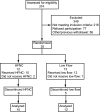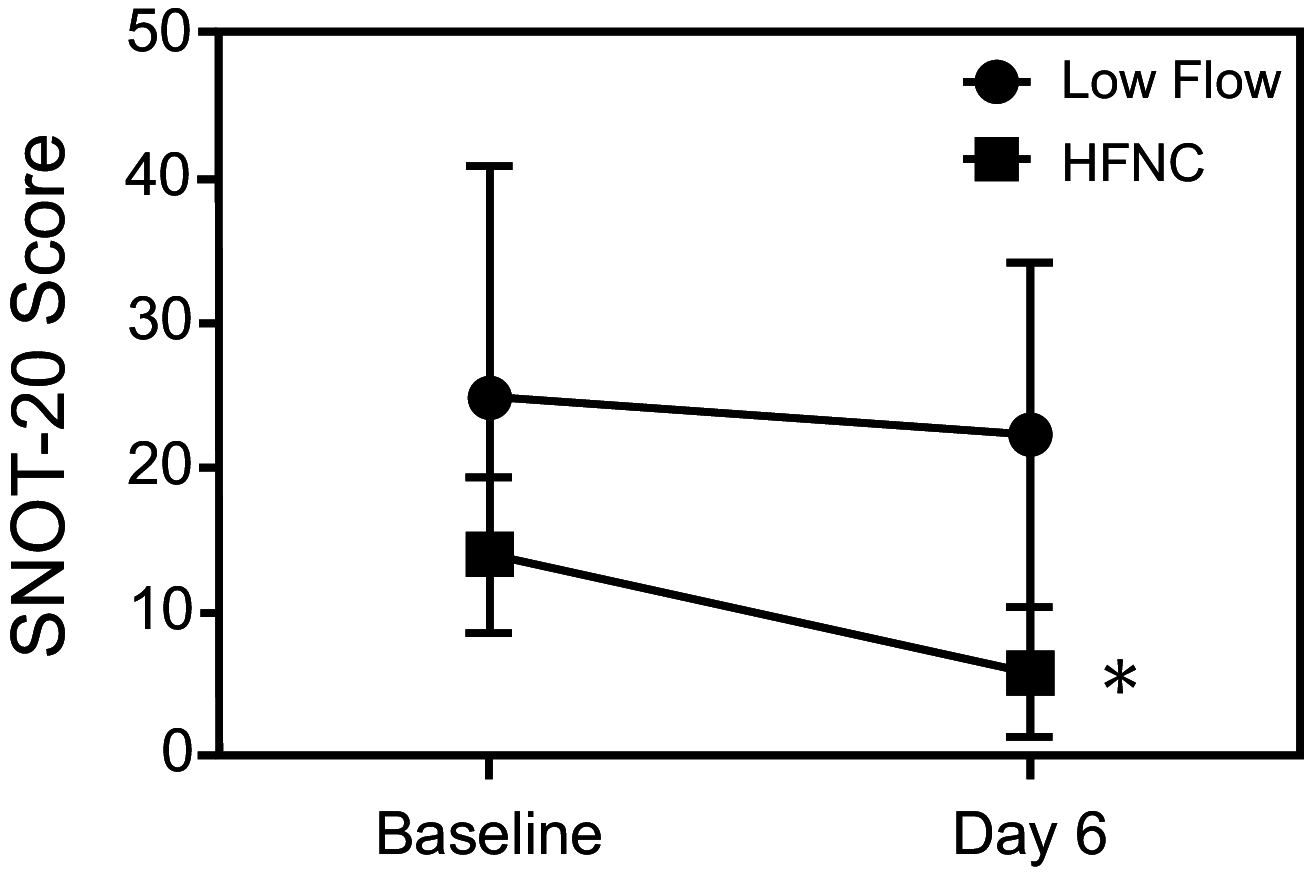Nocturnal High-Flow Nasal Cannula Therapy and Sinonasal Symptoms During Cystic Fibrosis Exacerbations
- PMID: 37253609
- PMCID: PMC10589103
- DOI: 10.4187/respcare.09890
Nocturnal High-Flow Nasal Cannula Therapy and Sinonasal Symptoms During Cystic Fibrosis Exacerbations
Abstract
Background: Both nasal obstruction and sleep disturbance are common in patients with cystic fibrosis (CF). In patients with obstructive sleep apnea (OSA), studies suggest that these conditions are related and that nasal congestion improves with CPAP therapy. We hypothesized that subjects admitted to hospital for therapy of an exacerbation of CF would have both nasal symptoms and sleep disturbance and that these would improve with the initiation of nocturnal high-flow nasal cannula therapy (HFNC).
Methods: Twenty-five subjects with an exacerbation of CF were enrolled to randomly receive either 5 d of nocturnal HFNC at 20 L/min in the treatment group or 5 L/min of nocturnal nasal cannula air at ambient temperature and humidity in the low-flow group. On the first and last day of the study, the Sino-Nasal Outcome Test (SNOT-20) was administered to evaluate nasal symptoms, and sleep quality was measured using the Actiwatch 2.
Results: Fifteen subjects completed the study (6 HFNC, 9 low flow). We confirmed that subjects had significant sleep disturbance that did not improve over the 5 d of the study. Subjects also had disturbing nasal symptoms that significantly improved only in those receiving HFNC (pre 14 [20] vs post 6 [13], P = .027).
Conclusions: Similar to what has been reported in older subjects with OSA, nocturnal HFNC improves sinonasal symptoms in subjects with an exacerbation of CF. There was no measurable effect on sleep quality, which may be due to the short duration of the study, or to subjects being evaluated while being treated in a hospital setting.
Keywords: SNOT-20; high-flow nasal cannula; high-flow nasal therapy; nasal high-flow therapy; sleep.
Copyright © 2023 by Daedalus Enterprises.
Conflict of interest statement
Dr Davis is funded by NIH/NHLBI PO1 HL128192 and the Indiana CTSI UL 1 TR002529. Dr Davis is a patent holder of Optate. Dr Davis discloses a relationship with Airbase Breathing Company. The remaining authors have disclosed no conflicts of interest.
Figures



Similar articles
-
High-Flow, Heated, Humidified Air Via Nasal Cannula Treats CPAP-Intolerant Children With Obstructive Sleep Apnea.J Clin Sleep Med. 2017 Aug 15;13(8):981-989. doi: 10.5664/jcsm.6700. J Clin Sleep Med. 2017. PMID: 28728621 Free PMC article.
-
Comparison of high flow nasal cannula therapy to nasal oxygen as a treatment for obstructive sleep apnea in infants.Pediatr Pulmonol. 2024 Oct;59(10):2635-2640. doi: 10.1002/ppul.27109. Epub 2024 Jun 5. Pediatr Pulmonol. 2024. PMID: 38837889
-
High-flow nasal cannula compared with continuous positive airway pressure in the treatment of obstructive sleep apnea.Sleep Breath. 2022 Jun;26(2):549-558. doi: 10.1007/s11325-021-02413-0. Epub 2021 Jun 18. Sleep Breath. 2022. PMID: 34145538 Clinical Trial.
-
High-flow nasal cannula therapy for pediatric obstructive sleep apnea: a systematic review and meta-analysis.Eur Rev Med Pharmacol Sci. 2022 Jul;26(13):4583-4591. doi: 10.26355/eurrev_202207_29179. Eur Rev Med Pharmacol Sci. 2022. PMID: 35856347
-
High flow nasal cannula in children: a literature review.Scand J Trauma Resusc Emerg Med. 2016 Jul 12;24:93. doi: 10.1186/s13049-016-0278-4. Scand J Trauma Resusc Emerg Med. 2016. PMID: 27405336 Free PMC article. Review.
References
-
- Rubin BK. Mucus, phlegm, and sputum in cystic fibrosis. Respir Care 2009;54(6):726–732; discussion 732. - PubMed
-
- Friedman EM, Stewart M. An assessment of sinus quality of life and pulmonary function in children with cystic fibrosis. Am J Rhinol 2006;20(6):568–572. - PubMed
-
- Robertson JM, Friedman EM, Rubin BK. Nasal and sinus disease in cystic fibrosis. Paediatr Respir Rev 2008;9(3):213–219. - PubMed
-
- Safi C, DiMango E, Keating C, Zhou Z, Gudis DA. Sinonasal quality of life declines in cystic fibrosis patients with pulmonary exacerbations. Int Forum Allergy Rhinol 2020;10(2):194–198. - PubMed
-
- McNamara DG, Asher MI, Rubin BK, Stewart A, Byrnes CA. Heated humidification improves clinical outcomes compared to a heat and moisture exchanger in children with tracheostomies. Respir Care 2014;59(1):46–53. - PubMed
MeSH terms
Grants and funding
LinkOut - more resources
Full Text Sources
Medical

